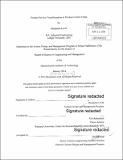Product service transformation in product-centric firms
Author(s)
Levitt, Benjamin (Benjamin P.)
DownloadFull printable version (12.01Mb)
Other Contributors
System Design and Management Program.
Advisor
Eric Rebentisch.
Terms of use
Metadata
Show full item recordAbstract
In slow or no-growth economies, firms cannot rely solely on recurring business from large, core customers who often delay or cancel capital investments in belt-tightening times. To achieve growth, firms must lever domain knowledge to expand business markets to find new customers. A core method to accomplish this expansion is through service models that can provide recurring revenues without as much up-front investment for customers. However, in a product-centric firm, the process of transforming a product into a service can be complex, and is the motivation for this research. No other complete explanation of this process has been published to date. The goal of researching this process is to give direction to managers who are considering transforming a product into service. The research led to building a service model using the Collaborative Adaptive Sensing of the Atmosphere (CASA) Radar System as its subject. The CASA Radar System is an X-Band Phased-Array Radar used for weather forecasting and environmental warning, led by University of Massachusetts with the assistance from several universities and industry partners. The radar system provides capabilities that did not exist previously in larger and less price effective systems, but was only available to be acquired directly, for upwards of $600 million. The CASA model sought to show how transforming the radar system from a product to a service could create value for the UMASS led team by selling more systems in a new service model to new customers, including weather-sensing firms and non-profits that want access to the CASA Radar System and would even pay for it, but were unable to support its standard capital costs.
Description
Thesis: S.M. in Engineering and Management, Massachusetts Institute of Technology, Engineering Systems Division, System Design and Management Program, 2014. Cataloged from PDF version of thesis. Includes bibliographical references (pages 95-97).
Date issued
2014Department
System Design and Management Program.; Massachusetts Institute of Technology. Engineering Systems DivisionPublisher
Massachusetts Institute of Technology
Keywords
Engineering Systems Division., System Design and Management Program.